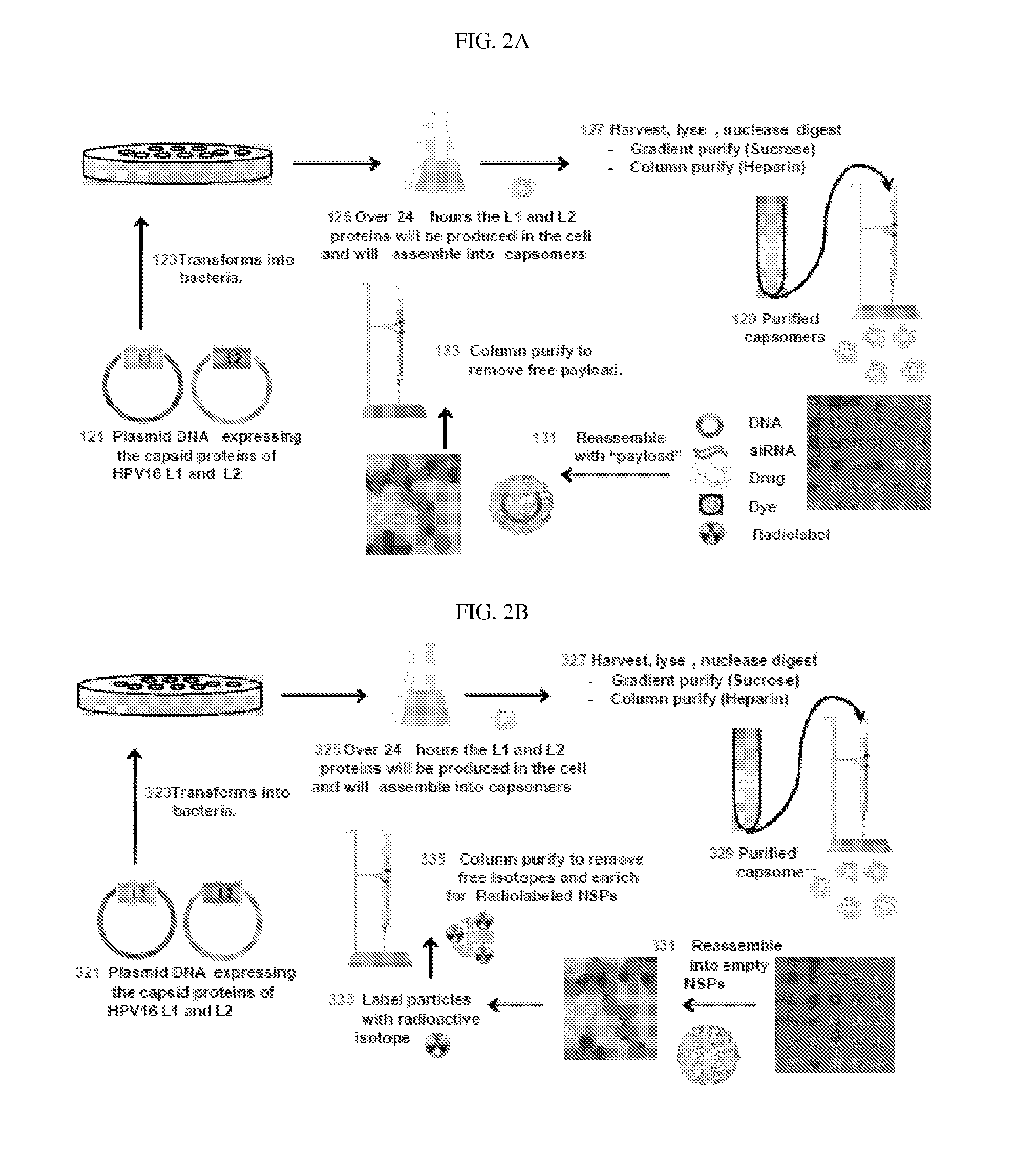Virion-derived nanospheres for selective delivery of therapeutic and diagnostic agents to cancer cells
- Summary
- Abstract
- Description
- Claims
- Application Information
AI Technical Summary
Benefits of technology
Problems solved by technology
Method used
Image
Examples
example 1
Production of Mutant L1* and L2 Capsid Proteins in E. coli Cell System (FIG. 2A)
[0148]Purification of VLPs by Sucrose Gradient Centrifugation
[0149]Make a stock solution of 65% sucrose by dissolving 32.5 g of crystalline sucrose (Fisher cat. #57-50-1) to a final volume of 50 ml sample buffer. Sample buffer used for VLP purification is 0.5M NaCl (American Bioanalytical cat. # AB01915) in sterile 1×PBS (Boston BioProducts cat. # BM 220S).
[0150]Make different concentrations of sucrose solution as described in Table 1 by mixing appropriate volumes of 65% sucrose stock solution (Step 1) in sample buffer.
TABLE 1mlFinal65%mlsucrose %stockbuffer507.692.31406.153.85304.625.38203.086.92101.548.46
[0151]Gently overlay decreasing concentrations of sucrose (highest concentration at the bottom) in a Beckman Polyallomer centrifuge tube (Cat. #326819). The volumes of different sucrose concentrations in the tube are as follows:
65% 0.5 ml50% 0.5 ml40%0.75 ml30%0.75 ml20%0.75 ml10%0.75 ml-1 ml
[0152]Keep...
example 2
Production of Mutant L1* and L2 Capsid Proteins in Mammalian Cell System (FIGS. 4A & B)
[0183]Plasmids containing human-optimized codon sequences were used to produce HPV16 / 31L1 mutant (L1*) and a HPV16L2 capsid proteins using a mammalian cell culture system, as follows.
[0184]HPV L1 / L2 nanosphere particles and L1 only nanosphere particles were added to disassembly buffer (0.5 M NaCl, 10 mM DTT (Dithiothreitol), 20 mM EDTA (Ethylenediaminetetraacetic acid), 50 mM Tris-HCl (pH 8.0)) to reach a final concentration of 0.05 mg / ml. The solution was incubated overnight at 37° C.
[0185]The HPV nanosphere particles were then concentrated to between 0.1-0.2 mg / ml using 100 kD spin columns. DNA or siRNA was added at a ratio of 1 μg of nucleic acid for every 5 μg of nanosphere particle. The resultant mixture was dialyzed using 100 kD cut-off dialysis tubing against one of two reassembly buffers: (1) 0.5M NaCl, 5 mM CaCl2, 40 mM HEPES (pH 6.8); or (2) 0.5M NaCl, 5 mM CaCl2, 40 mM Histidine-HCl (pH...
example 3
Biodistribution Study in Parental SKOV3 Orthotopic Tumor Model with Spontaneous Metastasis (FIGS. 5A &B)
[0191]An orthotopic murine model for ovarian cancer with spontaneous metastases was used to compare the specificity and efficiency of the nanosphere particle of the present invention with a human papilloma virus (HPV) virus-like particle (VLP) (also referred to herein as PsV particles) for measuring biodistribution. Three groups of severe combined immunodeficiency (SCID) female mice received implantation of SKOV3 (ATCC) parental tumor cell line by unilateral ovarian graft. The experiment was designed to compare HPV pseudovirus (PsV) particles to the nanosphere particles of the present invention. Subjects in group 3 received a single intraperitoneal injection of nanosphere particles (0.65 ml) when tumor sizes reached medium to large by palpitation on day 77 post-tumor implantation.
[0192]FIG. 5A shows the results of in vivo bioluminescent signals as 48 hours after dosing. FIG. 5B sh...
PUM
| Property | Measurement | Unit |
|---|---|---|
| Molar density | aaaaa | aaaaa |
| Molar density | aaaaa | aaaaa |
| Acidity | aaaaa | aaaaa |
Abstract
Description
Claims
Application Information
 Login to View More
Login to View More - R&D
- Intellectual Property
- Life Sciences
- Materials
- Tech Scout
- Unparalleled Data Quality
- Higher Quality Content
- 60% Fewer Hallucinations
Browse by: Latest US Patents, China's latest patents, Technical Efficacy Thesaurus, Application Domain, Technology Topic, Popular Technical Reports.
© 2025 PatSnap. All rights reserved.Legal|Privacy policy|Modern Slavery Act Transparency Statement|Sitemap|About US| Contact US: help@patsnap.com



